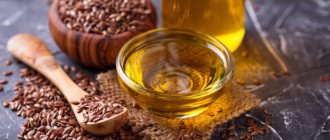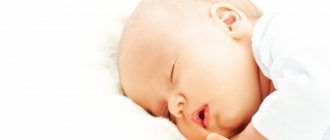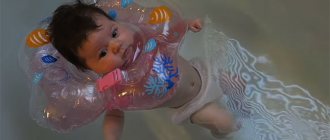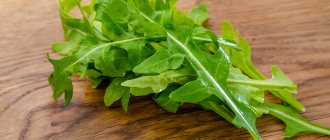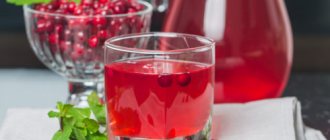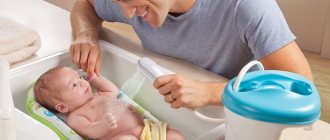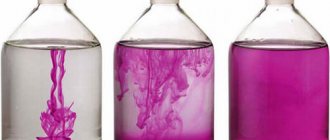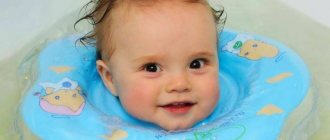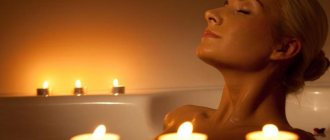Caring for the umbilical cord
After the baby is born, the umbilical cord is cut off, tied or a special clamp is applied. The umbilical cord residue, the length of which usually does not exceed 10 cm, gradually dries out and falls off on its own within 3-15 days. You should not “help” the umbilical cord to fall off (twist, pull), as this can cause bleeding.
Currently, the so-called “dry management” of the umbilical cord remains is practiced:
- The umbilical cord residue must be kept dry until it falls off; ideally, it should be left uncovered by clothing in the air, if the temperature in the room allows
- Do not injure with disposable diapers or elastic bands
- The umbilical cord should be kept clean: all clothes should be washed and ironed, the mother's hands should always be washed with soap
- The umbilical cord residue should not be treated with any antiseptics, since along with the pathogenic flora, the normal flora populating the skin is also destroyed
- If the umbilical cord remains are accidentally contaminated, rinse it thoroughly with sterile water. If sterile water is not available, use boiled water and soap. Then dry with sterile gauze and leave in the air.
If the umbilical cord has not fallen off on the 15th day of the baby’s life, you should consult a doctor.
Until the umbilical cord has fallen off, the child cannot be bathed: during this period, it is recommended to wash the face daily with cool water, wash the butt under warm running water after each bowel movement, daily wipe the baby’s body with a sponge or soft piece of cloth soaked in warm boiled water 37-38⁰C (umbilical cord the remainder remains dry).
After the umbilical cord has fallen off, you can begin bathing.
Bathing a baby
You need to purchase separate bath towels for your baby. They should be of such a size that they can completely envelop the child. There are towels with a corner in the form of a cap-hood; such a towel is very comfortable, protects well from drafts, and there is no need to immediately put the cap on the child’s head. It is also important to have separate towels for washing and cleaning the baby.
The skin of a newborn is very fragile and delicate, easily injured, so there is no need to use washcloths (they are also not necessary, since the child does not get dirty). It is enough to gently wash the child by hand. It is allowed to use natural sea sponges for washing, since they are very gentle and do not injure the skin. Choose a natural, non-dyed sponge to reduce the risk of possible allergies. Also on sale are foam sponges or terry mittens, which gently and gently cleanse the skin. However, in the first days it is better to do without using washcloths.
Before bathing your child, you need to prepare yourself. The baby has very delicate skin, so mom or dad must have their nails trimmed so as not to injure the baby. Also, parents should not have wounds or inflammations on their hands, as there is a risk of infection becoming attached to the baby.
The temperature in the room where bathing is planned should be comfortable for a naked baby, preferably not lower than 24 degrees. It is also necessary to monitor the water temperature. The optimal temperature for bathing a baby is considered to be 36-37 degrees. In slightly cooler water, the baby will most likely move more actively, get tired faster and, as a result, fall asleep more quickly. You can check the comfort of the water by dipping your elbow in the water, but it is better to purchase a special children's water thermometer. It will help monitor the temperature of the water during swimming so that it does not get too cold. If the water in the water supply is hard, it is better to first pass it through a filter. You can use herbs: a decoction of chamomile or calendula softens the water and prevents irritation of the baby's skin.
The process of bathing a newborn baby begins with preparation: make sure that everything you need is at hand. In addition, a place must be prepared for an already clean baby. Spread a towel on the changing table, prepare the necessary cream, diaper, and clean things.
Fill the bath with water, lower the thermometer and bring the water to the desired temperature of 36-37° C. Undress the baby and carefully lower it slowly into the water. Your hand should hold the baby by the shoulders from below, and his head should be located in the area of your wrist. Use your free hand to gently pour water over your baby. Talk while bathing, soothe him with your voice so that he does not get scared. Before you start washing your child, let him get comfortable and get used to it, soothe him with massage movements of your hand. After this, you can start swimming. If the baby cried when he got into the water, then a possible reason could be that the temperature is uncomfortable for him. Try making the water a little warmer or cooler, watch the child’s reaction. Also try not to create a lot of splashes; if they get on his face, he may get scared.
Air baths
Before bathing, let your baby lie undressed for 1-2 minutes. Air baths stimulate skin breathing, prevent diaper rash and give the mother the opportunity to do gymnastics with the baby in a calm environment or give him a light massage. In the future, the duration of air baths can be increased, and by the end of the first year of life the baby can be without clothes for up to 30 minutes. Remember that the temperature in the room during an air bath for a child in the first month of life should be 20-24⁰C.
A decoction of string for a newborn
The baby's skin is vulnerable to external influences, so it is necessary to take care of it. The umbilical wound requires special attention - it is an ideal place for bacteria to multiply. Therefore, you need to monitor the child’s hygiene, do not forget about regular bathing and use antiseptics.
A decoction of the string dries the skin, relieves itching and redness, which often bother a newborn. Due to its anti-inflammatory and soothing properties, it can be used for burns and insect bites or to prevent inflammation.
Alternate treatment is usually prescribed for the following problems:
- prickly heat,
- diathesis,
- diaper rash,
- hives,
- dermatitis,
- eczema,
- milky crust on the head.
It should be remembered that the effect of bathing does not occur immediately. Only on day 4-5 the rashes begin to disappear. If there is no visible result, it is better to bathe the baby in another decoction.
If you are not ready to dilute the decoction, try bathing foam with a string of My Sun®. It contains string extract and rice milk, which soothes irritated skin. The foam gently cleanses the baby's skin, leaving it soft after rinsing. It is suitable for daily use from the first days of life. In addition, the product has been clinically tested and recommended by pediatricians.
Bathing
A newborn should be bathed daily. This procedure is necessary not only to maintain cleanliness - bathing stimulates blood circulation, strengthens the nervous system and promotes the psychomotor development of the child. To make water procedures enjoyable for your baby, bathe him in the evening before evening feeding.
If the umbilical wound is not healed, the newborn should be bathed in boiled warm water at a temperature of +35-38⁰C in a baby bath. Be sure to use a special thermometer, since determining the water temperature “by touch” is not suitable for bathing a child - this is due to differences in temperature sensitivity and comfort temperature in an adult and a newborn.
To avoid excessive drying of the skin, the baby is bathed with baby soap only once a week, the rest of the time limited to water. You can add brewed herbs that have a calming and bactericidal effect to the bath for bathing a newborn: chamomile, string.
It is best to bathe your baby at the same time to develop a routine. Bathing lasts 10-15 minutes depending on the child’s mood. At the end of the water procedures, the child’s skin must be gently blotted with a soft towel - there is no need to wipe off the moisture.
After bathing, do not forget to lubricate all folds of the skin with baby milk or cream and, if necessary, clean the baby’s ears with cotton wool.
Cooking rules
If you bought a ready-made mixture, the instructions for it should indicate how to brew a series for bathing newborns. Different sources prescribe different proportions, sometimes very far from each other in terms of values. Which one is the most optimal? It is better to listen to the opinion of pediatricians.
- Infusion
The infusion of the series takes the longest to prepare for bathing newborns, so you need to take care of it in advance. Pour 30 grams of dry herb into a glass of boiling water that has just been removed from the heat. If you do this in a thermos, the healing liquid can be filtered after 6 hours and poured into the bath. You can simply leave it in any container, covering it with a lid. But then you will have to wrap it in a warm terry towel and keep it there for 12 hours before using it directly.
- Decoction
A decoction of the string is prepared much faster, which can also be used for bathing newborns. Here, a lower concentration of medicinal raw materials will be required, because it will give all its beneficial properties to water much faster under the influence of heat treatment. A glass of water is poured into 15 grams of dry plant. After this, there are two ways to continue preparing the potion:
— place the container in a water bath and simmer for 20 minutes; -put it directly on the stove, bring to a boil, reduce the heat and keep on it for 10-15 minutes.
Now the broth is filtered and poured into the bath while hot.
- Phytopackages
If you have a string in bags, brew it in the same way as regular plant materials:
— for infusion — 2 packets per glass of water; - for decoction - 1 packet for the same amount.
After 6 hours of settling or 15 minutes of boiling on the stove, strain and pour into the bath.
There are different opinions about how many sachets of string to brew for bathing a newborn. The most important rule here is to do no harm. And to do this, you need to remember that the herb has a strong drying effect on children's skin, so it is better to reduce the proportions somewhere, but not increase them, so that the solution in the bath does not turn out to be too concentrated. And this applies not only to phytopackages.
- Solution
It remains to figure out how to create a series for bathing a newborn, so as not to harm, but to get the maximum benefit from this herbal bath. In different sources you can find proportions that differ from each other, but it is better to take the average value between them:
- a glass of infusion/decoction for the bath; - a glass of infusion/decoction for 30 liters of water.
The question of how much string is needed to bathe a newborn is decided by the parents themselves almost “by eye.” In doing so, they must be guided by two points. Firstly, the solution should not be concentrated so as not to dry out the delicate baby skin. Secondly, it should be light brown in color, reminiscent of weak tea.
- Combo
If the pediatrician advised bathing the newborn in string and chamomile (for inflammatory rashes on the body), dry herbs are mixed in equal proportions (1 tablespoon for infusion, half a tablespoon for decoction, 1 filter bag) and filled with water as indicated in the recipe.
However, you should not do such combinations on your own: they require a doctor’s prescription. There is an opinion that it is better to use herbs for such purposes alone, without mixing with other plants.
Now you know how to brew a series for bathing a newborn and dilute it in water. If you do everything correctly, you will get a real healing solution that will improve the condition of children's skin and protect it from infections and germs. But that is not all. In order for it to work and fulfill its purpose, the process of the water procedure itself is very important, about which it will be useful for parents to learn a few nuances.
Helpful information. Only one variety of string has medicinal properties - tripartite. Radiation and drooping are very similar to it, but they cannot be used in folk medicine.
Treatment of the umbilical wound
If the umbilical wound has not yet healed, it should be treated after bathing. To do this, use a 3% solution of hydrogen peroxide and 70% ethyl alcohol (instead of alcohol, you can use a 5% solution of potassium permanganate). Drop a drop of peroxide into the navel, then gently wipe the discharge with a piece of sterile bandage, then drop a drop of 70% ethyl alcohol there and blot with a bandage.
Do not use cotton swabs for this procedure - the less you injure the baby’s navel, the faster it will heal. Recently, it has been recommended to refrain from using dyes so as not to miss redness and other signs of inflammation of the umbilical wound. Treatment of the navel is stopped when the umbilical wound is completely healed - as a rule, this happens after 5-7 days.
How to brew a batch for a newborn
The series is sold in three types:
- bagged (on average, you will need 6 sachets per 10 liters of water),
- a scattering of grass (3 tablespoons per 10 liters)
- extract (dilute in water according to instructions).
It is easier to fill a bathtub with a concentrate, but it will also cost more - the product has a high consumption. Especially considering that a standard bathtub holds 40 liters of water, and a regular cast iron bathtub holds 200 liters.
Sachets are the best option for bathing, since the solution does not have to be filtered. Place the bags in a mug or thermos with boiling water, cover with a lid and let sit for at least a couple of hours. Then squeeze out the bags and use a decoction of the string to bathe the baby.
The loose string is in no way inferior to the bagged variety in terms of impact. Depending on the degree of skin damage, you can add more or less string. You need to brew the herb in the same way: place it in a container, cover with a lid and let it brew, then strain through cheesecloth or a sieve and start bathing.
There are several more ways to prepare a decoction of the string:
- pour boiling water over the herb and keep on low heat for 10 minutes,
- brew the infusion in a water bath: pour boiling water over the herb in a jar, place it in a tall saucepan, pour hot water into it, cover the jar with a saucer or lid and boil over low heat for 15 minutes. After this, remove from the stove and leave with the lid closed for at least an hour. Then you can pour the broth into the bathtub and bathe the child.
How often should you bathe?
If the child does not have skin problems, bathing is preventative. In this case, you should not do baths with a series more than once a week.
If the newborn has irritation, eczema, or diathesis, the number of baths should be increased to two times. The duration of treatment is 5-6 weeks, and the result from using the series will become noticeable already on the third.
The first bath takes no more than 5 minutes, then the procedure can be extended to 20 minutes. Usually, a newborn quickly gets used to swimming in aromatic water and enjoys spending a lot of time there. If the baby is unhappy, you need to pull him out of the water: the procedure should be pleasant and not cause stress to the child.
Video about bathing a newborn in a line
In the following video, the famous doctor Komarovsky E.O. shares his opinion on bathing a newborn in a series, and also gives a recipe for brewing a solution for the bath.
In an effort to avoid unnecessary worries for the baby and mother, remember the main thing - only a balanced, conscious and competent attitude to herbal medicine can benefit your child. If your newborn has a smooth, tender body with clean, velvety skin, bathe him in plain water without any herbs. This way you will protect yourself from unnecessary problems, and your baby from additional worries.
Nature has given us a lot of benefits for the health, growth and development of a child, let's use them wisely. And let your children grow up healthy and actively explore the world! Have you bathed your children in a line? Share your experience in the comments.
When is a bath with infusion of the series indicated for a baby?
The sequence has a positive effect on the baby’s body. Each of the elements listed above has a positive effect on the baby’s skin.
A bath with a series is indicated for infants in the following cases:
- for diathesis, diaper rash;
- inflammation, prickly heat;
- for eczema, itching, milky crust on the crown of the head;
- in the presence of ulcers, urticaria, hyperexcitability.
Parents should remember that when using a series to bathe their baby, they should not expect instant action.
The rashes present on the skin will not disappear the next day. The therapeutic effect occurs only after 4-5 procedures. However, if no changes have occurred after a while after taking baths with a series, it is recommended to use another herbal decoction.
If the baby has an allergic reaction (not to a series) or a rash, you can bathe the child in a special solution every other day. In this case, the concentration of the herbal solution should not be too high.
Useful properties of the plant and solution based on it
As you know, newborn babies have delicate skin and a fragile nervous system. The string is a unique plant that was literally created by nature to help babies in the first months of life.
The plant has many beneficial properties and components, which include:
- tannins : are a natural antiseptic;
- ascorbic acid : soothes baby skin and relieves irritation;
- mucous substances : envelop the skin and also improve the digestion process;
- essential oils : moisturizes and nourishes children's skin, removes rough areas, removes crusts on the body.
In addition, the sequence includes many valuable substances: micro- and macroelements.
A properly prepared infusion of string dries problem areas, heals wounds, and also has an antifungal effect. If you regularly bathe your child in a decoction of the string, the body and nervous system of the newborn will be strengthened.
Every pediatrician and experienced mother knows that if a baby has heat rash or skin irritation, to eliminate this problem it is necessary to bathe the child at night in a series.
Bathing a baby in a decoction of string is useful for the following reasons:
- the decoction relieves itchy skin and heals small wounds;
- after bathing, the newborn calms down and quickly falls asleep;
- Bathing in a solution of string helps to improve the health of the child’s body and strengthen the immune system.
Despite the fact that the series is unique in its properties, it is recommended to consult a pediatrician before using it.
The doctor will tell you whether it is possible to bathe the child in the series solution in a particular case. The baby's first bath in a series should not last more than 5 minutes. The second procedure may last 5 minutes longer. The third time, bathing time can be increased to 15 minutes.
This time is quite enough to treat inflamed skin. It is important that bathing does not become painful for the child. The process must necessarily bring pleasure and joy to the child. Parents, in turn, need to provide for all contingencies and think through every little detail.
Since bathing in a series is considered a medical procedure, after such a bath creams, powder and other cosmetic substances should not be applied to the baby’s skin. By reacting with natural grass, chemical elements can provoke an aggressive reaction.

